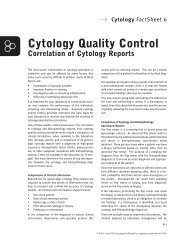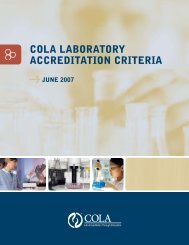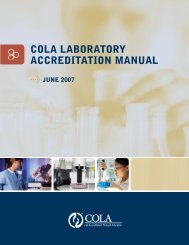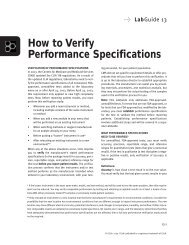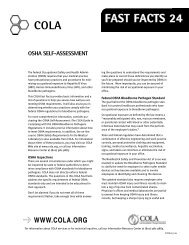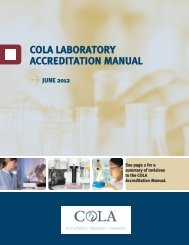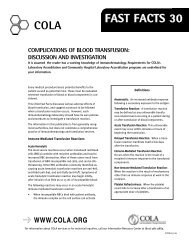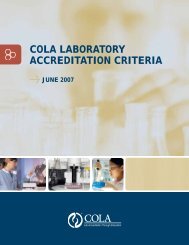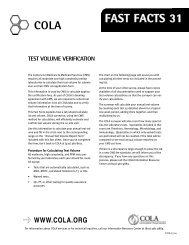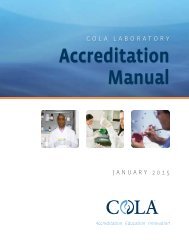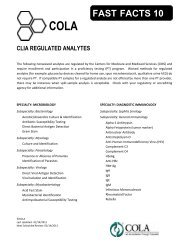Incident Management: Developing a Plan - COLA
Incident Management: Developing a Plan - COLA
Incident Management: Developing a Plan - COLA
You also want an ePaper? Increase the reach of your titles
YUMPU automatically turns print PDFs into web optimized ePapers that Google loves.
<strong>COLA</strong> LABGUIDE 71<br />
<strong>COLA</strong><br />
Requirements<br />
are<br />
underlined.<br />
As stated previously, the intent of this criterion is to<br />
focus attention on the most serious consequences<br />
and outcomes that may occur as a result of laboratory<br />
activities.<br />
Systemic Non-Compliance<br />
Systemic non-compliance with stated policies and<br />
procedures has the potential to cause errors in all<br />
phases of laboratory testing. Systemic noncompliance<br />
is observed when several laboratory<br />
systems, for example, quality control performance,<br />
calibration, reagent use, and adherence to testing<br />
procedures are not performing as expected. The<br />
combination of repetitive problems in these testing<br />
systems results in an intertwining condition that is<br />
considered to be systemic non-compliance.<br />
When these systems combine to produce errors that<br />
have a significant impact on the accuracy and reliability<br />
of test results and lead to negative outcomes for<br />
patients they become incidents. For example,<br />
repeated failure to recognize that reagents are out of<br />
date and that the controls are out-of-range for a<br />
critical assay such as prothrombin time or digoxin<br />
could impact the accuracy of patient results.<br />
Treatment decisions based on inaccurate results<br />
could have disastrous results for the patient.<br />
When Errors Become <strong>Incident</strong>s<br />
The following are examples where laboratory errors<br />
can lead to incidents:<br />
• Analytical processes such as incorrect test results<br />
that lead to misdiagnosis or improper treatment.<br />
• Safety issues such as accidents or improper<br />
disposal of contaminated waste causing injury to<br />
staff or patients.<br />
• Test tracking errors such as reporting a result on<br />
the wrong patient or mislabeling of a specimen<br />
leading to disastrous results.<br />
• Recurring complaints such as patients reporting<br />
excessive pain, burning, numbness or tingling<br />
from phlebotomy that could indicate an injury<br />
from the procedure.<br />
HOW QA CAN HELP IDENTIFY INCIDENTS<br />
An effective QA process can be instrumental in<br />
recognizing potential incidents. Even though they<br />
occur infrequently, incidents that result in or have the<br />
potential to result in death or serious injury to patients<br />
or staff must be planned for and carefully evaluated<br />
when they occur to eliminate the chance for recurrences.<br />
Learn to expect the unexpected. Have policies and<br />
procedures in place to address how staff should<br />
respond and specific actions to take when faced with<br />
an incident. The laboratory can identify, learn from<br />
and prevent incidents from occurring by developing<br />
and implementing an <strong>Incident</strong> <strong>Management</strong> <strong>Plan</strong> that<br />
is an extension of the overall QA <strong>Plan</strong>.<br />
DEVELOPING AN INCIDENT<br />
MANAGEMENT PLAN<br />
The laboratory must have written polices and procedures<br />
that describe the actions to be taken in response<br />
to an incident. These policies and procedures<br />
must be followed whenever an incident occurs. Develop<br />
forms to document incidents when they occur<br />
and retain all documentation regarding incidents. The<br />
laboratory must ensure that the following processes<br />
and their underlying elements are addressed by its<br />
incident management policies and procedures:<br />
• Identification of <strong>Incident</strong>s<br />
Define in general terms what would be considered<br />
an incident in your laboratory. Describe how you<br />
would determine if an event/error constitutes an<br />
incident. Further clarify by listing the types of<br />
incidents that could possibly occur, even if they<br />
seem unlikely. Remember, the key here is to<br />
expect the unexpected. Don’t dismiss a potential<br />
incident by thinking, “It couldn’t happen here.”<br />
Collect and verify the facts when an incident is<br />
identified. Be specific and include dates and<br />
details.<br />
• Evaluation of the <strong>Incident</strong> to Determine the<br />
True Cause<br />
State the steps you will take to investigate the<br />
incident and determine the true cause. (See<br />
Written Investigation Procedure on next page.)<br />
Each incident should be reviewed on a case-bycase<br />
basis and discussed promptly so that the<br />
problem can be addressed immediately. Identify<br />
who will be responsible for each step in the<br />
process. Determinations will need to be made<br />
about the medical significance of the incident<br />
and whether testing should be stopped.<br />
• Correction of <strong>Incident</strong>s<br />
Develop a corrective action plan and implement<br />
the corrections. Some actions might include<br />
71-2<br />
© <strong>COLA</strong>--5/03. <strong>COLA</strong> LabGuide® is a registered trademark of <strong>COLA</strong>.<br />
The information in this LabGuide is based on sound laboratory practice--it does not necessarily reflect <strong>COLA</strong> accreditation criteria.




